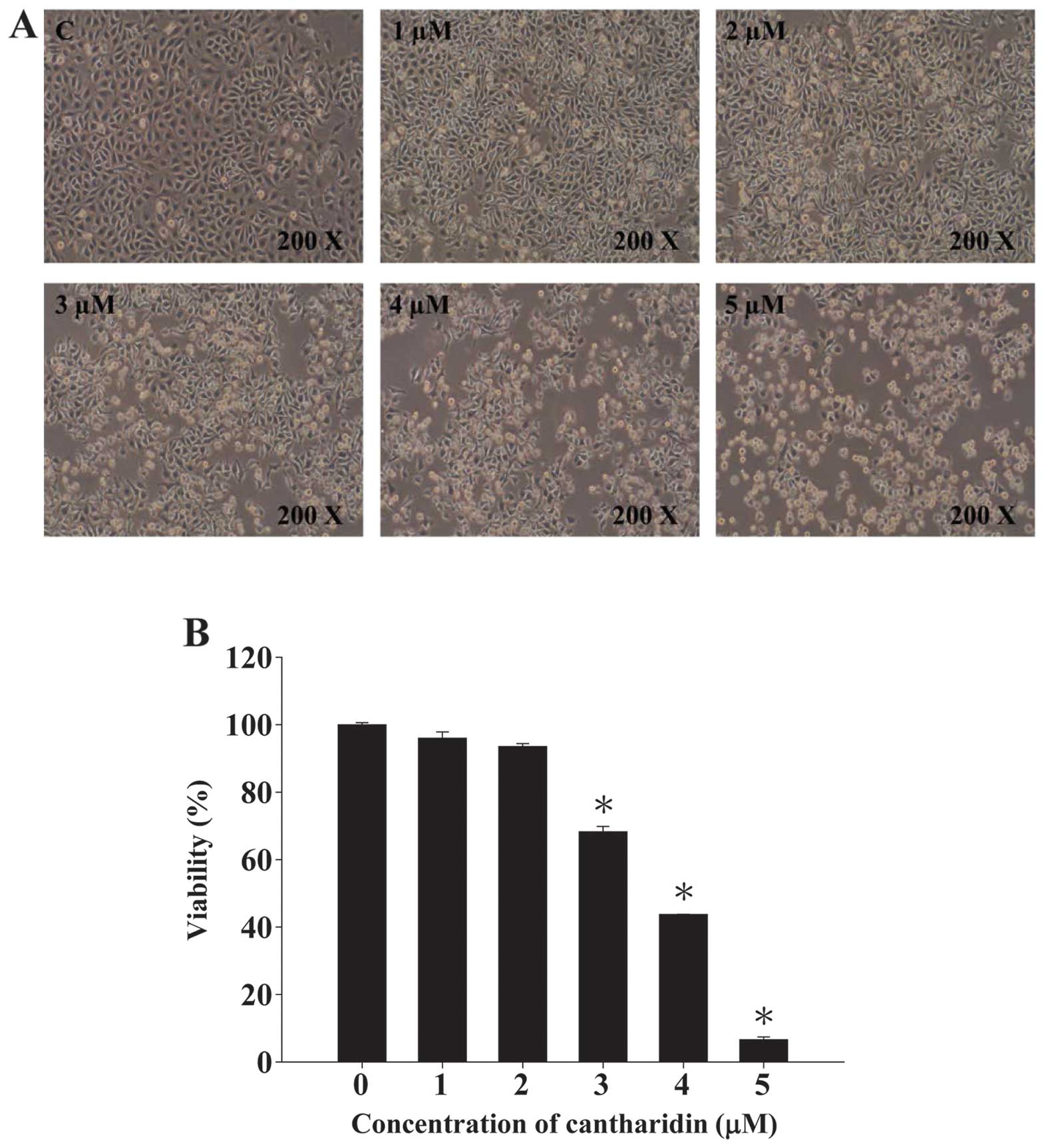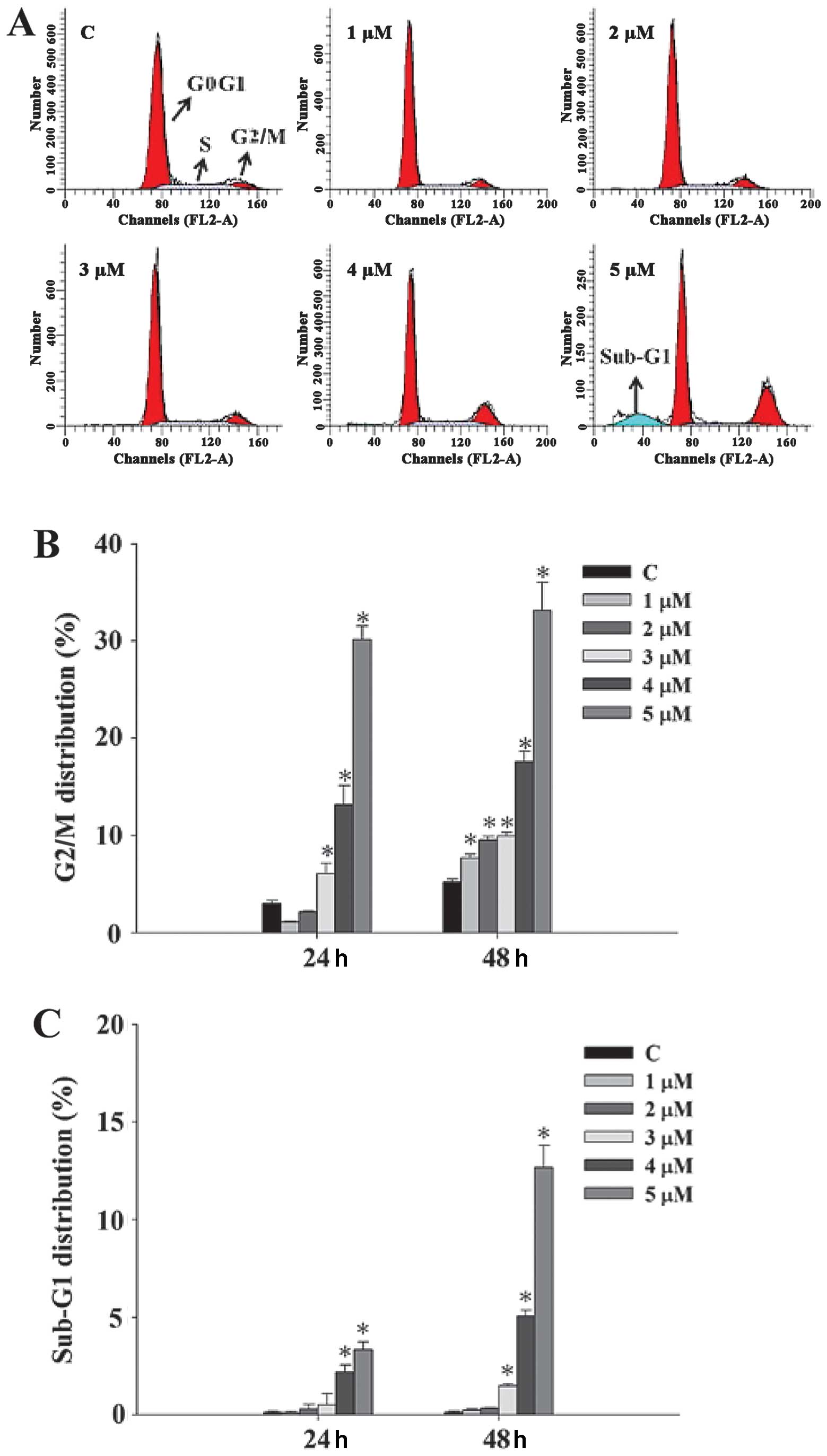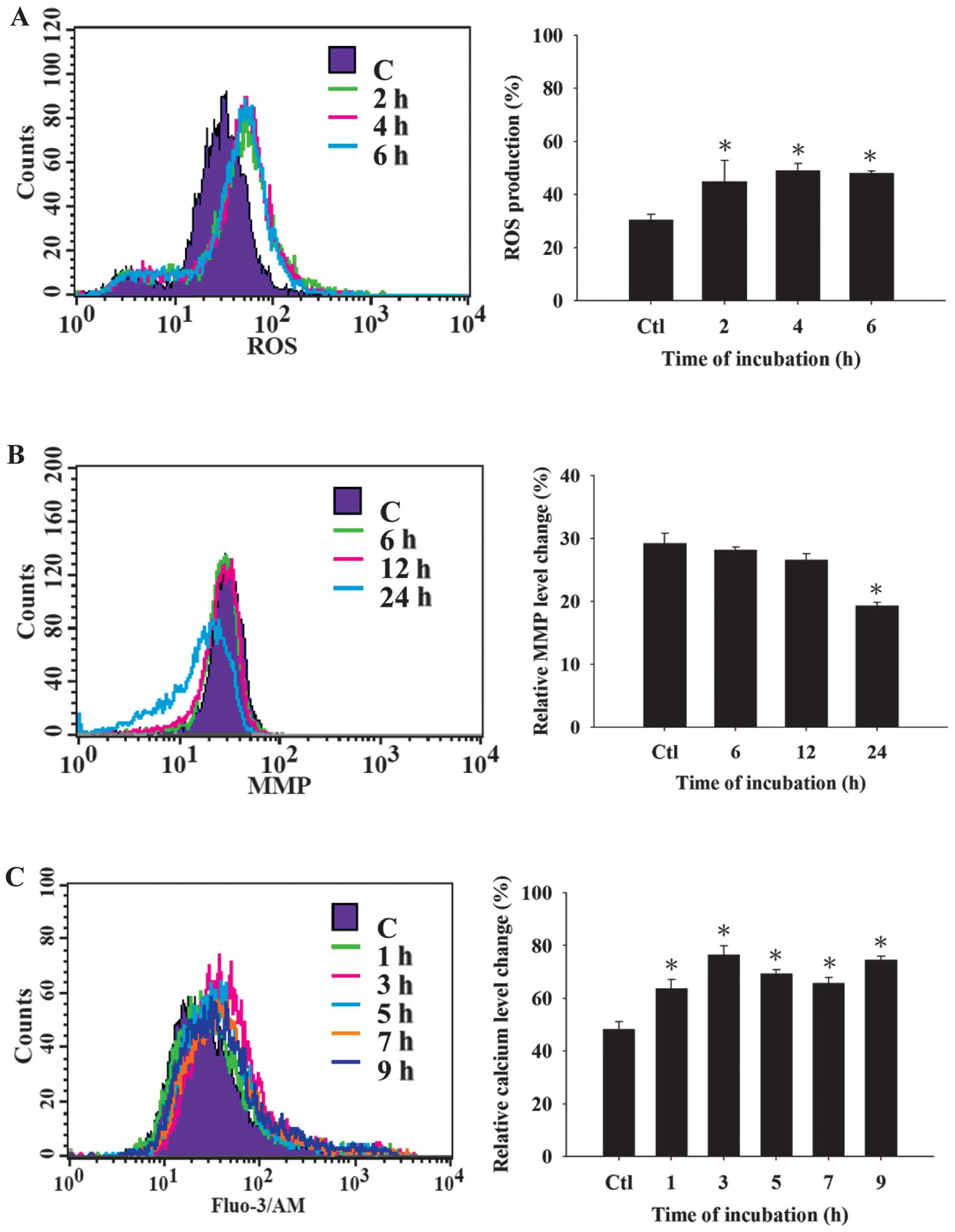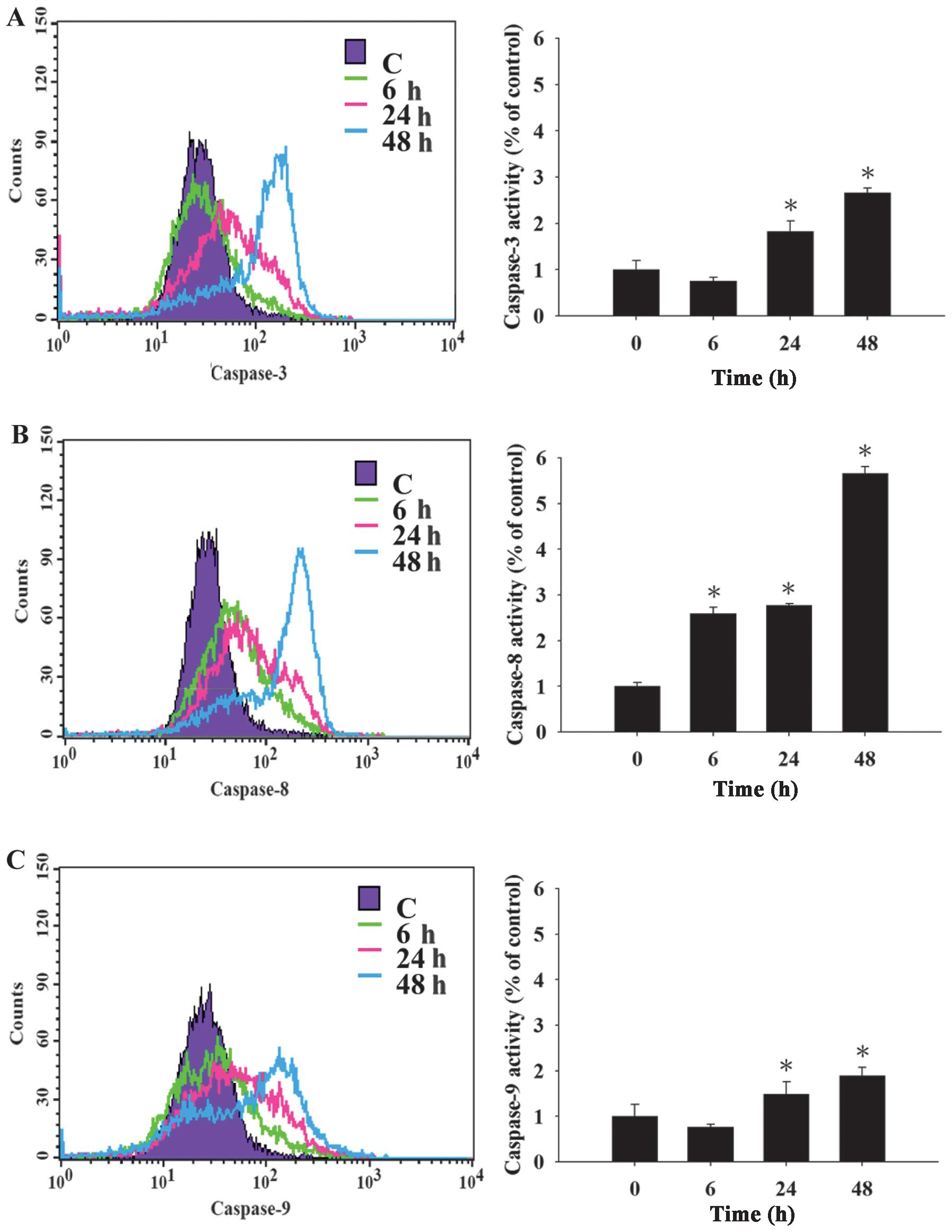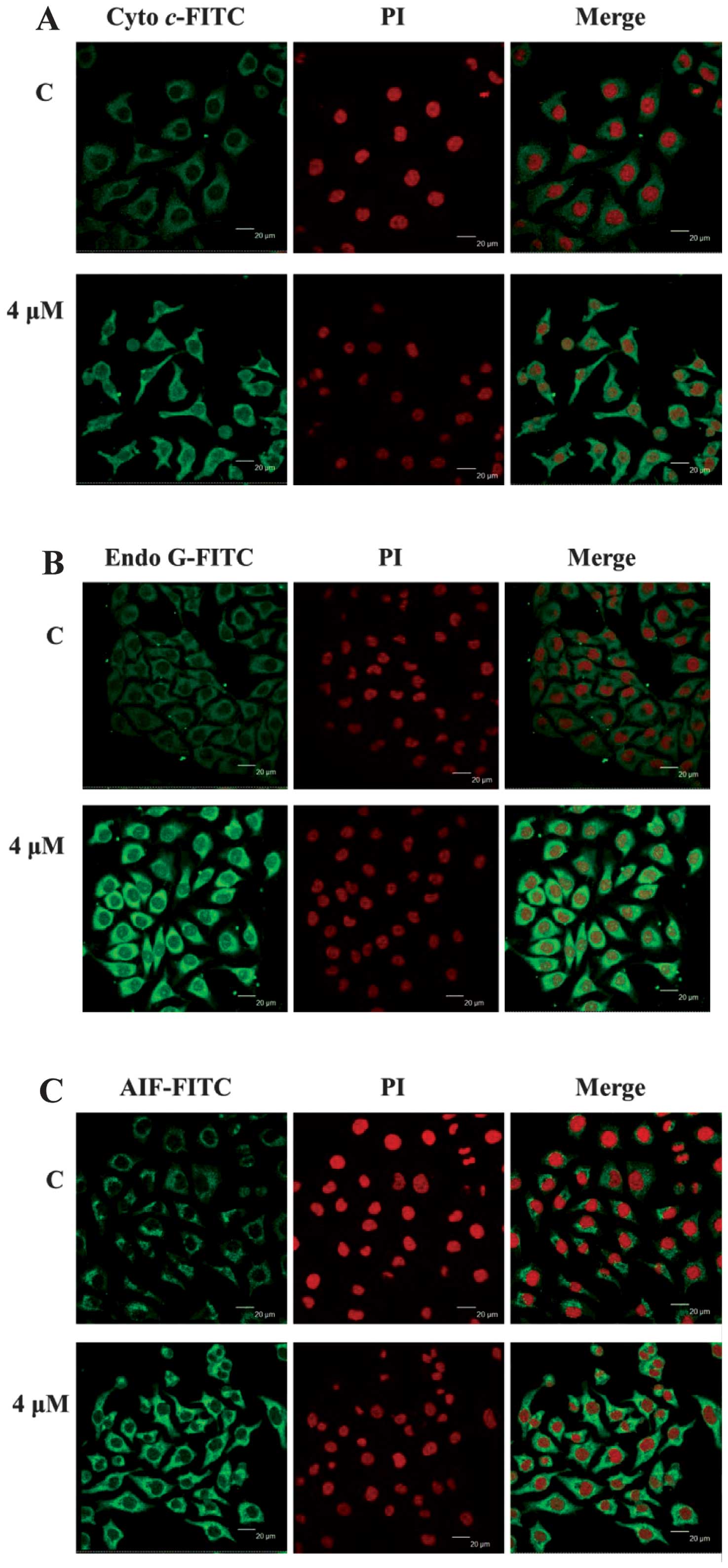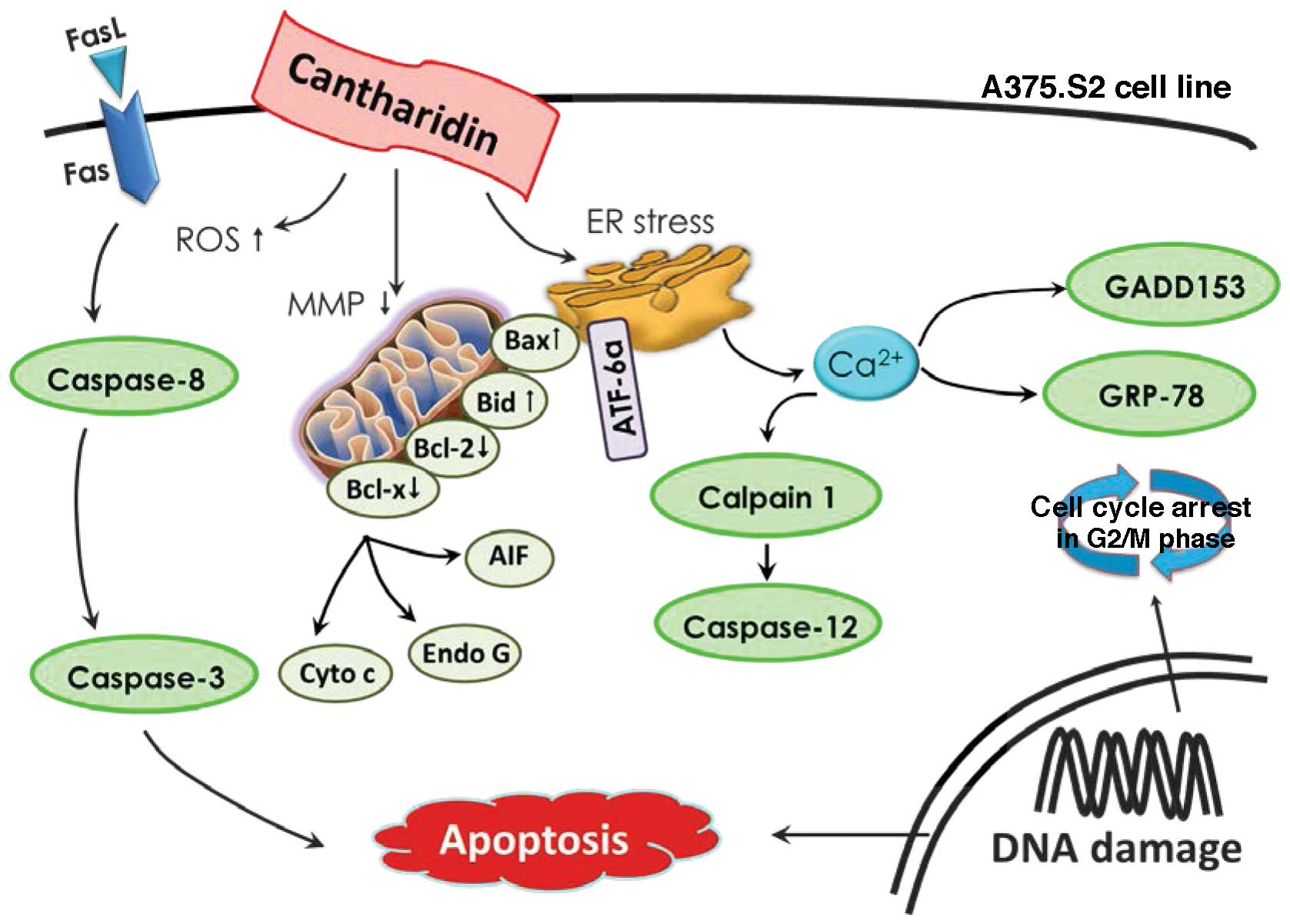Cantharidin induces G2/M phase arrest by inhibition of Cdc25c and Cyclin A and triggers apoptosis through reactive oxygen species and the mitochondria‑dependent pathways of A375.S2 human melanoma cells
- Authors:
- Published online on: September 30, 2014 https://doi.org/10.3892/ijo.2014.2689
- Pages: 2393-2402
Abstract
Introduction
Human melanoma, an aggressive skin cancer, accounts for 10% of all skin cancers, but was estimated to be involved in >80% of deaths from skin cancers (1). In Western countries, skin cancer melanoma is becoming more common and resulting in increased mortality (2). In the USA, the incidence of melanoma has increased by 15-fold in the last 40 years (1,3). In individuals of European origin, the incidence of melanoma is still rising (4). Survival ratio for metastatic melanoma is low and the 10-year survival rate for patients with metastatic melanoma is <10% (5,6). It was reported that human melanoma is highly resistant to conventional chemotherapy (7). Currently, the effective treatment of human melanoma such as surgery, radiation, chemotherapy or a combination of radiotherapy with chemotherapy is not satisfactory. Thus, numerous studies had focused on finding novel potent drugs from natural products to combat this disease.
In nature, insects produce different defensive molecules against predators, and these molecules may be clinically used as medicinal drugs for therapeutic purposes (8). The dried body of mylabris (Mylabris phalerata Pallas) has been used in Chinese traditional medicine for the treatment of cancer (9). Cantharidin (CTD), a terpenoid, was isolated from mylabris (blister beetles) and other insects and was shown to induce cancer cell apoptosis in leukemia (10), myeloma (11), bladder (12), breast (13), colon (14), liver (15), pancreatic (16) and lung (17). It was reported that CTD inhibits migration and invasion of A549 human lung cancer cells via the inhibition of matrix metalloproteinase 2 (18). Recently, we also found that CTD induces cell apoptosis through mitochondria-dependent pathways (18) and induced DNA damage and inhibits DNA repair-associated protein levels in NCI-H460 human lung cancer cells (19).
Numerous studies have shown that CTD induced cytotoxic effects in many human cancer cell lines through the induction of apoptosis, however, there is no available information to show CTD-induced apoptosis in human skin cancer cells. Therefore, in the present study, A375.S2 human melanoma cells were selected for use as a cell model to investigate the anti-melanoma potential of CTD in vitro. The results indicated that CTD induced G2/M phase arrest and cell apoptosis in A375.S2 cells via the caspase- and mitochondrial-dependent signaling pathways.
Materials and methods
Chemicals and reagents
CTD, propidium iodide (PI), Trypsin-EDTA, dimethyl sulfoxide (DMSO) and DAPI were purchased from Sigma Chemical Co. (St. Louis, MO, USA). CTD was dissolved in DMSO to make a stock solution. Minimum essential medium (MEM), fetal bovine serum (FBS), L-glutamine and penicillin-streptomycin were purchased from Gibco®/Invitrogen Life Technologies (Carlsbad, CA, USA). Primary antibody such as WEE1, Cdc25c, Cyclin A, CDK1, p21, Fas, Fas-L, AIF, Endo G, cytochrome c, caspase-3, -8 and -9, Bax, Bid, Bcl-2, Bcl-x, XBP-1, GADD153, GRP78, caspase-12, IRE1β, ATF6α and Calpain 1 and peroxidase conjugated secondary antibodies were purchased from Cell Signaling Technology, Inc. (Beverly, MA, USA). The enhanced chemiluminescence (ECL) detection system was obtained from Amersham Life Science, Inc. (Arlington Heights, IL, USA).
Cell culture
The A375.S2 human malignant melanoma cancer cells were obtained from the Food Industry Research and Development Institute (Hsinchu, Taiwan). The cells were cultured in MEM supplemented with 10% FBS, 1% antibiotics (100 U/ml penicillin and 100 μg/ml streptomycin) and 2 mM L-glutamine (Gibco®/Invitrogen Life Technologies, Grand Island, NY, USA) and maintained at 37°C with 5% CO2 in a humidified atmosphere. The medium was changed every 2 days (20–22).
Observation of morphological changes and measurement of viable cells
A375.S2 cells (2×105 cells/well) were seeded into 12-well plates for 24 h. CTD diluted in DMSO was then individually added to a final concentration of 0, 1, 2, 3, 4 and 5 μM, and an equal amount of DMSO was added to the well as the control group for 48 h. The cellular morphology was observed and photographed by using a phase contrast microscope at magnification of ×200. Cells from each well were harvested for the measurement of percentage of viability using a flow cytometric method (BD Bioscience FACSCalibur flow cytometer; Becton-Dickinson, San Jose, CA, USA) as described previously (20).
Measurement of cell cycle distribution by flow cytometry
A375.S2 cells (2×105 cells/well) were seeded into 12-well culture plates for 24 h and then were incubated with 0, 1, 2, 3, 4 and 5 μM of CTD, or only with vehicle (DMSO, 1% in culture media) for 24 and 48 h. Cells were harvested by centrifugation and washed with phosphate-buffered saline (PBS). Then cells were fixed with 70% ethanol overnight at least for 24 h at 4°C and were washed twice with PBS and stained with 1 ml PI working solution (100 μg/ml RNase A, 40 μg/ml PI and 0.1% Triton X-100) for cellular staining at room temperature for 30 min in the dark. Analysis of cell cycle distribution was performed by a flow cytometer and analyzed by Cell Quest software package (BD Bioscience FACSCalibur flow cytometer; Becton-Dickinson) as described previously (20). Each experiment was repeated three times.
Reactive oxygen species (ROS), intracellular Ca2+ and mitochondrial membrane potential (ΔΨm) assays
Flow cytometry was used for measuring the levels of ROS, Ca2+ and Δψm in A375.S2 cells. Briefly, A375.S2 cells (2×105 cells/well) placed in 12-well plates for 24 h were then treated with 4 μM of CTD for various time periods. The cells were collected from each timer point and then re-suspended in 500 μl of DCFH-DA (10 μM) for 30 min for ROS (H2O2) measurement, re-suspended in 500 μl of DiOC6 (4 μM) for 30 min for the levels of Δψm measurement and re-suspended in 500 μl of Fluo-3/AM (2.5 μg/ml) for 30 min for intracellular Ca2+ measurement and all samples were analyzed by flow cytometry as described previously.
Caspase-3, -8 and -9 activity assay
A375.S2 cells (2×105 cells/well) were seeded onto 12-well plates for 24 h and then were pre-treated with Z-VAD-FMK, Z-IETD-FMK, Z-LEHD-FMK and Z-DEVD-FMK (inhibitors of caspase-pan, -8, -9 and -3, respectively) and then treated with 4 μM of CTD for 0, 6, 24 and 48 h. Then cells were harvested and washed with PBS, and were re-suspended in 50 μl of 10 μM substrate solution of caspase-8, -9 and -3 substrates (CaspaLux8-L1D2, CaspaLux9-M1D2 and PhiPhiLux-G1D2, respectively) (OncoImmunin, Inc., Gaithersburg, MD, USA) for 30 min in the dark. Cells were measured for the activities of caspase-8, -9 and -3 by using flow cytometric assay as described previously (20).
Western blotting
A375.S2 cells (1×106 cells/dish) were placed in 10 cm dish for 24 h and then were incubated with or without 4 μM CTD for 0, 6, 12, 24 and 48 h then lysed in an ice-cold lysis buffer [10 mM Tris-HCl (pH 7.4), 150 mM NaCl, 1 mM EGTA, 0.3 mM PMSF, 0.2 mM sodium orthovanadate, 0.1% SDS, 1 mM EDTA, 1% NP-40, 10 mg/ml leupeptin, and 10 mg/ml aprotinin], followed by denaturation. Then centrifuged at 13,000 rpm for 20 min at 4°C, before getting the supernatant to measure protein concentration by using a Bio-Rad protein assay kit (Bio-Rad, Hercules, CA, USA). Protein (30 μg) was electrophoresed in 12% SDS-PAGE gel at 4°C, steady flow (10 mA in composition gel, 15 mA in separation gel) followed by transfer onto nitrocellulose membranes. The membranes were blocked with 5% skim milk in TBST (20 mmol/l Tris-HCl at pH 8.0, 150 mmol/l NaCl, and 0.05% Tween-20) for 1 h at room temperature, and then probed with relevant primary antibodies (anti-WEE1, Cdc25c, Cyclin A, CDK1, p21, Fas, Fas-L, AIF, Endo G, cytochrome c, caspase-3, -8 and -9, Bax, Bid, Bcl-2, Bcl-x, XBP-1, GADD153, GRP78, caspase-12, IRE1β, ATF6α and Calpain 1) overnight at 4°C followed by peroxidase-conjugated secondary antibody for 1 h at 25°C. Proteins on the membrane were visualized by ECL detection (Amersham Biosciences ECL™) and exposed to X-ray film and bands obtained were quantified using NIH Image analyzer (NIH, Bethesda, MD, USA). β-actin staining served as the internal standard for the membranes. All of the western blots were performed at least three times (21,22).
Confocal laser scanning microscopy assay
A375.S2 cells (5×104 cells/well) were placed on 4-well chamber slides and incubated with or without 4 μM CTD for 48 h and then fixed in 4% formaldehyde in PBS for 15 min, and they were permeablized using 0.3% Triton X-100 in PBS for 1 h, followed using 2% BSA for blocking non-specific binding sites. Cells were stained by primary antibodies such as anti-Endo G, anti-cytochrome c and anti-AIF (all in green fluorescence) overnight and then washed with PBS. Cells were incubated with fluorescein isothiocyanate-conjugated second antibody (Santa Cruz Biotechnology, Santa Cruz, CA, USA) followed by mitotracker (red fluorescence) staining for nuclein examination. The stained cells were analyzed with Leica TCS SP2 Confocal Spectral Microscope as described previously (23,24).
Statistical analysis
All data were expressed as mean ± SD from triplicate experiments. Statistically significant of differences between the CTD-treated and -untreated (control) groups were assessed by Student’s t-test with SPSS 11.0 statistic software. P<0.05 was considered statistically significant.
Results
CTD induced cell morphological changes and decreased the cell viability of A375.S2 cells
A375.S2 cells were pre-incubated with 0, 1, 2, 3, 4 and 5 μM of CTD for 48 h then cells were photographed by phase contrast microscopy and were harvested for the total percentage of viable cells and the results are shown in Fig. 1A and B. Fig. 1A shows that CTD induced cell morphological changes. Fig. 1B shows a significant dose-dependent reduction of living cells with CTD treatment when compared to the control groups in A375.S2 cells and these effects are dose-dependent.
CTD induces G2/M phase arrest and sub-G1 phase (apoptosis) of A375.S2 cells
A375.S2 cells were treated with various doses of CTD for 24 and 48 h before the cells were examined for sub-G1 phase in cell cycle assay by flow cytometry and the results are shown in Fig. 2A–C. Fig. 2A shows representative profiles from flow cytometry assay indicating that CTD induced sub-G1 phase and G2/M phase arrest in A375.S2 cells. Data in Fig. 2B and C indicate that CTD induced G2/M phase arrest and induced sub-G1 phase development, respectively, and these effects are dose-dependent. At the 48-h treatment of CTD, a higher percentage of G2/M phase arrest and sub-G1 phase (apoptosis) was recorded than that of control groups.
CTD induces ROS and Ca2+ production and decreases the levels of Δψm in A375.S2 cells
In order to confirm whether CTD induced apoptotic cell death in A375.S2 cells via the production of ROS and Ca2+ or dysfunction of mitochondria, cells were treated with CTD then analyzed by flow cytometry and the results are shown in Fig. 3A–C. Fig. 3A shows that CTD increased ROS production at 2–6 h of treatment. Furthermore, CTD induced Ca2+ production (Fig. 3C) from 1–9 h of treatment in A375.S2 cells and these effects are time-dependent. However, Fig. 3B indicates that CTD decreased the levels of Δψm at 24-h of treatment and shows that CTD-induced apoptosis of A375.S2 cells is associated with dysfunction of mitochondria.
CTD affects the activities of caspase-8, -9 and -3 in A375. S2 cells
To confirm whether CTD induced apoptosis through the activation of caspase-8, -9 and -3 in A375. S2 cells, cells were pre-treated with or without the inhibitors (Z-VAD-FMK, Z-IETD-FMK, Z-LEHD-FMK and Z-DEVD-FMK: caspase-pan, -8, -9 and -3, respectively) and then were treated with 4 μM of CTD and were harvested and assessed by flow cytometric assay and the results are shown in Fig. 4A–D. Results from Fig. 4A–C indicate that CTD increased the activities of caspase-8, -9 and -3 and these effects are time-dependent. Cells were pre-treated with the inhibitors of caspase-pan, -8, -9 and -3 and then were treated with CTD and the total percentage of viable cells were measured and the results (Fig. 4D) show increased percentage of viable cells when compared to the treatment without the inhibitor. These results showed that CTD induced apoptosis via the caspase-dependent pathway.
CTD affects G2/M phase arrest and apoptosis-associated protein expression in A375.S2 cells
To further investigate whether CTD induced G2/M phase arrest and apoptosis in A375.S2 cells through the presented alterations of G2/M phase and apoptosis-associated protein, cells were treated with 4 μM of CTD for 0, 6, 12, 24 and 48 h and then the associated protein alterations were examined by western blotting and the results are shown in Fig. 5A–D. Fig. 5A indicates that CTD inhibited Cdc25c, Cyclin A and CDK1 but increased p21 and WEE1 proteins in A375.S2 cells. These cellular proteins were known to respond to G2/M phase in cell cycle progression. We inferred that CTD could bring about the proteolytic activations of various G2/M phase proteins to obstruct the cell cycle progression of A375.S2 cells. Results in Fig. 5C show that CTD significantly increased the expression of Fas, Fas-L, and caspase-8 that is associated with the extrinsic pathway. Furthermore, results show that CTD increased cytochrome c, AIF, Endo G, caspase-9 and -3 (Fig. 5C), increased Bid, Bax, but decreased the levels of Bcl-2, Bcl-x and XBP-1 (Fig. 5B) that are all associated with the intrinsic apoptotic pathway. Additionally, Fig. 5D indicates that CTD increased ER stress-associated protein expression such as GADD153, GRP78, IRE1β, Calpain 1, ATF6α and caspase-12. These results indicate that CTD induced G2/M phase arrest via inhibited cell cycle progression-associated protein and induced apoptosis through the extrinsic, intrinsic and ER stress pathways in A375.S2 cells.
CTD affected the translocation of apoptotic associated proteins in A375.S2 cells
To further confirm that CTD affects the translocation of cytochrome c, AIF, and Endo G involved in apoptosis in A375.S2 cells, cells were treated with 4 μM of CTD for 48 h and then stained by anti-cytochrome c, AIF and Endo G to examine and photograph by confocal laser microscopic systems. Results show that CTD promoted Endo G (Fig. 6B), cytochrome c (Fig. 6A), AIF (Fig. 6C) releases from mitochondria in A375.S2 cells when compared to untreated (control) groups that indicated CTD induced apoptosis via the mitochondria-dependent pathway.
Discussion
It was reported that >50% of anti-cancer drugs used in patients are directly or indirectly derived from natural plants (24). CTD, a natural active compound isolated from various insects, was found to have in vitro antitumor activity against many human cancer cell lines (10–17). In this study, for the first time, we demonstrated that CTD induced G2/M phase arrest via the inhibition of Cdc25c and cyclin A and induced apoptosis was through death receptor (extrinsic), intrinsic (mitochondria) and ER stress pathways in A375. S2 cells. Furthermore, results indicated that CTD induced cell morphological changes (Fig. 1A) and decreased the percentage of viable cells (Fig. 1B) via the induction of G2/M phase arrest, sub-G1 phase (apoptosis) (Fig. 2).
It is well known that cells undergo cell cycle from G0/G1, S, and G2/M phase that are controlled by checkpoint-associated proteins (23,25) and agents including anticancer drugs can affect checkpoint proteins distributing the progression of cell cycle then leading the cells to undergo apoptosis (26,27). Herein, we found CTD induced G2/M phase arrest in A375.S2 cells, it also inhibited the protein expression of Cdc25c, Cyclin A and CDK1 (Fig. 6A) that are associated with G2/M arrest.
It is well documented that the induction of apoptosis triggered by anticancer drugs has been recognized as the best strategy for anticancer therapy (28,29). It was reported that intracellular ROS generation plays an important role in physiological and pathological processes. Furthermore, higher ROS is involved in apoptotic cell death (30). Mitochondria plays a critical role in cell apoptosis (31,32) and has been suggested to act as the central executioner in apoptotic signaling pathways (33). We found that CTD increased the production of ROS (Fig. 3A) time-dependently and decreased the levels of Δψm (Fig. 3B) in A375.S2 cells. It was reported that the mitochondria-derived ROS is caused by the dysfunction of mitochondrial electron transport chain (34). These observations indicated the mitochondrial dysfunction occurred during CTD-induced A375.S2 cell apoptosis. At 48-h of CTD treatment, it led to mitochondria dysfunction and results from western blotting also showed that CTD increased the release of cytochrome c, AIF and Endo G (Fig. 5C) release. Furthermore, it increased Bid and Bax but decreased Bcl-2 and Bcl-x (Fig. 5B) in A375. S2 cells. Bcl-2 gene family is divided mainly into the Bax, Bcl-2, and Bid proteins. Bax is an apoptosis-promoting protein, while Bcl-2 is an anti-apoptotic protein that plays a critical role in regulating cell apoptosis (35,36). By western blotting we found that the expression of Bax was increased and that of Bcl-2 was reduced in A375.S2 cells when treated with CTD, therefore increasing the Bax/Bcl-2 ratio significantly.
Other studies have shown that oxidative stress stimulates translocation of Bax from cytosol to mitochondria causing cytochrome c release inside the cytoplasm during liver apoptosis (37). CTD-induced ROS generation, and we suggest that CTD-induced apoptosis might be modulated by the ROS-mediated pathways in A375.S2 cells.
It was well known that cysteine-containing aspartate-specific proteases (caspases) are involved in cell apoptosis (38,39). Caspase-8 is related to extrinsic pathway and caspase-9 is involved in the intrinsic pathway, however, caspase-3 is related to the common pathway of cell apoptosis and it is a key executor of cell apoptosis. In our study, the results in Fig. 5 show that increased activation of caspase-8, -9 and -3 (Fig. 4), and expression of protein (Fig. 6B) are associated with cell apoptosis. Furthermore, cells were pre-treated with the inhibitors of caspase-8, -9 and -3 and then treated with CTD leading to increase in the percentage of viable cells when compared to CTD only treated cells.
In conclusion, caspase-pathway activation, mitochondria dysfunction and oxidative stress (ROS generation) induced by CTD contribute to the activation of the apoptotic pathway in CTD-treated A375.S2 cells. Furthermore, the modulating expression and translocation of apoptotic proteins induced the mitochondrial pathways in A375.S2 cells as shown in Fig. 7. Based on these observations, CTD inhibits human skin cancer A375.S2 cellular growth and our studies provide a better understanding of the molecular mechanism of CTD function.
Acknowledgements
This study was supported in part by a research grant from China Medical University [CMU102-ASIA-20]. Experiments and data analysis were performed in part through the use of the Medical Research Core Facilities Center, Office of Research and Development at China medical University, Taichung, Taiwan, R.O.C.
References
|
Postovit LM, Margaryan NV, Seftor EA and Hendrix MJ: Role of nodal signaling and the microenvironment underlying melanoma plasticity. Pigment Cell Melanoma Res. 21:348–357. 2008. View Article : Google Scholar | |
|
Bergomi M, Pellacani G, Vinceti M, et al: Trace elements and melanoma. J Trace Elem Med Biol. 19:69–73. 2005. View Article : Google Scholar : PubMed/NCBI | |
|
Chudnovsky Y, Khavari PA and Adams AE: Melanoma genetics and the development of rational therapeutics. J Clin Invest. 115:813–824. 2005. View Article : Google Scholar : PubMed/NCBI | |
|
Thompson JF, Scolyer RA and Kefford RF: Cutaneous melanoma in the era of molecular profiling. Lancet. 374:362–365. 2009. View Article : Google Scholar : PubMed/NCBI | |
|
Miller AJ and Mihm MC Jr: Melanoma. N Engl J Med. 355:51–65. 2006. View Article : Google Scholar | |
|
Bhatia S, Tykodi SS and Thompson JA: Treatment of metastatic melanoma: an overview. Oncology (Williston Park). 23:488–496. 2009. | |
|
Gava B, Zorzet S, Spessotto P, Cocchietto M and Sava G: Inhibition of B16 melanoma metastases with the ruthenium complex imidazolium trans-imidazoledimethylsulfoxide-tetra-chlororuthenate and down-regulation of tumor cell invasion. J Pharmacol Exp Ther. 317:284–291. 2006. View Article : Google Scholar | |
|
Newman DJ, Cragg GM and Snader KM: The influence of natural products upon drug discovery. Nat Prod Rep. 17:215–234. 2000. View Article : Google Scholar : PubMed/NCBI | |
|
Wang GS: Medical uses of mylabris in ancient China and recent studies. J Ethnopharmacol. 26:147–162. 1989. View Article : Google Scholar : PubMed/NCBI | |
|
Xu B: The inf luence of several anticancer agents on cell proliferation, differentiation and the cell cycle of murine erythroleukemia cells. Am J Chin Med. 9:268–276. 1981. View Article : Google Scholar : PubMed/NCBI | |
|
Sagawa M, Nakazato T, Uchida H, Ikeda Y and Kizaki M: Cantharidin induces apoptosis of human multiple myeloma cells via inhibition of the JAK/STAT pathway. Cancer Sci. 99:1820–1826. 2008. View Article : Google Scholar : PubMed/NCBI | |
|
Kuo JH, Chu YL, Yang JS, et al: Cantharidin induces apoptosis in human bladder cancer TSGH 8301 cells through mitochondria-dependent signal pathways. Int J Oncol. 37:1243–1250. 2010.PubMed/NCBI | |
|
Williams LA, Möller W, Merisor E, Kraus W and Rösner H: In vitro anti-proliferation/cytotoxic activity of cantharidin (Spanish Fly) and related derivatives. West Indian Med J. 52:10–13. 2003.PubMed/NCBI | |
|
Huang WW, Ko SW, Tsai HY, et al: Cantharidin induces G2/M phase arrest and apoptosis in human colorectal cancer colo 205 cells through inhibition of CDK1 activity and caspase-dependent signaling pathways. Int J Oncol. 38:1067–1073. 2011. | |
|
Wang CC, Wu CH, Hsieh KJ, Yen KY and Yang LL: Cytotoxic effects of cantharidin on the growth of normal and carcinoma cells. Toxicology. 147:77–87. 2000. View Article : Google Scholar : PubMed/NCBI | |
|
Li W, Chen Z, Zong Y, et al: PP2A inhibitors induce apoptosis in pancreatic cancer cell line PANC-1 through persistent phosphorylation of IKKα and sustained activation of the NF-κB pathway. Cancer Lett. 304:117–127. 2011. | |
|
Hsia TC, Yu CC, Hsu SC, et al: Cantharidin induces apoptosis of H460 human lung cancer cells through mitochondria-dependent pathways. Int J Oncol. 45:245–254. 2014. | |
|
Kim YM, Ku MJ, Son YJ, Yun JM, Kim SH and Lee SY: Anti-metastatic effect of cantharidin in A549 human lung cancer cells. Arch Pharm Res. 36:479–484. 2013. View Article : Google Scholar : PubMed/NCBI | |
|
Hsia TC, Lin JH, Hsu SC, et al: Cantharidin induces DNA damage and inhibits DNA repair-associated protein levels in NCI-H460 human lung cancer cells. Environ Toxicol. Mar 17–2014.(Epub ahead of print). | |
|
Huang SH, Hsu MH, Hsu SC, et al: Phenethyl isothiocyanate triggers apoptosis in human malignant melanoma A375. S2 cells through reactive oxygen species and the mitochondria-dependent pathways. Hum Exp Toxicol. 33:270–283. 2014. View Article : Google Scholar | |
|
Chang Y-M, Velmurugan BK, Kuo W-W, et al: Inhibitory effect of alpinate Oxyphyllae fructus extracts on Ang II-induced cardiac pathological remodeling-related pathways in H9c2 cardiomyoblast cells. BioMedicine. 3:148–152. 2013. View Article : Google Scholar | |
|
Lin M-C, Tsai S-Y, Wang F-Y, Liu F-H, Syu J-N and Tang F-Y: Leptin induces cell invasion and the upregulation of matrilysin in human colon cancer cells. BioMedicine. 3:174–180. 2013. View Article : Google Scholar | |
|
Das KC and Ravi D: Altered expression of cyclins and cdks in premature infant baboon model of bronchopulmonary dysplasia. Antioxid Redox Signal. 6:117–127. 2004. View Article : Google Scholar : PubMed/NCBI | |
|
Lee KH: Anticancer drug design based on plant-derived natural products. J Biomed Sci. 6:236–250. 1999.PubMed/NCBI | |
|
Das KC and Wasnick JD: Biphasic response of checkpoint control proteins in hyperoxia: exposure to lower levels of oxygen induces genome maintenance genes in experimental baboon BPD. Mol Cell Biochem. 395:187–198. 2014. View Article : Google Scholar | |
|
Salameh A, Galvagni F, Anselmi F, De Clemente C, Orlandini M and Oliviero S: Growth factor stimulation induces cell survival by c-Jun. ATF2-dependent activation of Bcl-XL. J Biol Chem. 285:23096–23104. 2010. View Article : Google Scholar : PubMed/NCBI | |
|
Shirali S, Aghaei M, Shabani M, Fathi M, Sohrabi M and Moeinifard M: Adenosine induces cell cycle arrest and apoptosis via cyclinD1/Cdk4 and Bcl-2/Bax pathways in human ovarian cancer cell line OVCAR-3. Tumour Biol. 34:1085–1095. 2013. View Article : Google Scholar : PubMed/NCBI | |
|
Kelly PN and Strasser A: The role of Bcl-2 and its pro-survival relatives in tumourigenesis and cancer therapy. Cell Death Differ. 18:1414–1424. 2011. View Article : Google Scholar : PubMed/NCBI | |
|
Strasser A, Cory S and Adams JM: Deciphering the rules of programmed cell death to improve therapy of cancer and other diseases. EMBO J. 30:3667–3683. 2011. View Article : Google Scholar : PubMed/NCBI | |
|
Laurent A, Nicco C, Chéreau C, et al: Controlling tumor growth by modulating endogenous production of reactive oxygen species. Cancer Res. 65:948–956. 2005.PubMed/NCBI | |
|
Gillies LA and Kuwana T: Apoptosis regulation at the mitochondrial outer membrane. J Cell Biochem. 115:632–640. 2014. View Article : Google Scholar : PubMed/NCBI | |
|
Wang Z, Cai F, Chen X, Luo M, Hu L and Lu Y: The role of mitochondria-derived reactive oxygen species in hyperthermia-induced platelet apoptosis. PLoS One. 8:e750442013. View Article : Google Scholar : PubMed/NCBI | |
|
Crompton M: The mitochondrial permeability transition pore and its role in cell death. Biochem J. 341:233–249. 1999. View Article : Google Scholar : PubMed/NCBI | |
|
Murphy MP: How mitochondria produce reactive oxygen species. Biochem J. 417:1–13. 2009. View Article : Google Scholar : PubMed/NCBI | |
|
Korsmeyer SJ, Shutter JR, Veis DJ, Merry DE and Oltvai ZN: Bcl-2/Bax: a rheostat that regulates an anti-oxidant pathway and cell death. Semin Cancer Biol. 4:327–332. 1993.PubMed/NCBI | |
|
Lindsay J, Esposti MD and Gilmore AP: Bcl-2 proteins and mitochondria - specificity in membrane targeting for death. Biochim Biophys Acta. 1813:532–539. 2011. View Article : Google Scholar : PubMed/NCBI | |
|
Guha M, Kumar S, Choubey V, Maity P and Bandyopadhyay U: Apoptosis in liver during malaria: role of oxidative stress and implication of mitochondrial pathway. FASEB J. 20:1224–1226. 2006. View Article : Google Scholar : PubMed/NCBI | |
|
Galluzzi L, Vitale I, Abrams JM, et al: Molecular definitions of cell death subroutines: recommendations of the Nomenclature Committee on Cell Death 2012. Cell Death Differ. 19:107–120. 2012. View Article : Google Scholar : PubMed/NCBI | |
|
Kroemer G, Galluzzi L and Brenner C: Mitochondrial membrane permeabilization in cell death. Physiol Rev. 87:99–163. 2007. View Article : Google Scholar : PubMed/NCBI |



